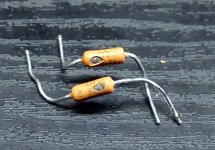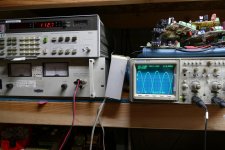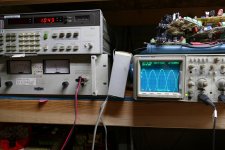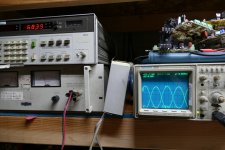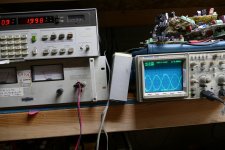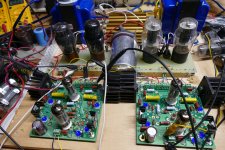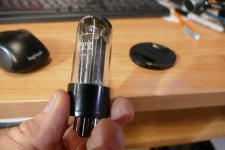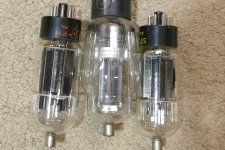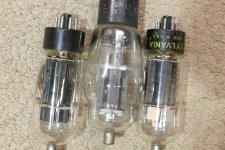I have a UNSET PP design that I am noodling. When biased to operate in class A the limit to power is when the grid goes positive. Is it worth it to add a voltage follower from the grid voltage divider (R3/R5, R1/R2) to the grid to allow a little bit of class A2 or are we in the diminishing returns zone?

The original test board that led to the UNSET design had a tube socket with a pair of mosfets tied to the cathode, control grid, and screen grid configured so that I could source or sink current into or out of each of these elements while biasing them to any reasonable DC voltage superimposed with AC drive of either polarity from a push pull driver. The original goal was to find a way to make sweep tubes work in pseudo triode mode with a fixed or driven screen grid at a considerably lower voltage than the plate. Pseudo triode mode was obtained with the "Schade" feedback divider from plate to grid. The initial testing did have an N channel mosfet follower feeding the control grid from this divider, with the +150 volt screen supply on its drain. After finding that most, if not all sweep tubes can pass plenty of current with their control grids negative and therefore drawing very low current the mosfet follower was eliminated and I never looked back.
Experiments with the 6L6 family of tubes revealed that they like A2 and AB2 and can offer a considerable power output increase when the control grid is driven positive. Most of my testing involved push pull operation with a standard common cathode output stage with G1 driven by a mosfet follower. I have a box full of old used 6L6G's and 6L6GA's, so I picked out 4 that were strong and reasonably matched and pushed them to their limits.
Despite some serious spec violation the 6L6GA's just kept on going. I ran successive tests with ever increasing plate supply voltages searching for the limit. Here is the 525 volts into a 3300 ohm load test. The scope trace shows the control grid on each output tube. The center line is zero volts with 20 volts / division sensitivity.
At this point in the test we have entered AB2 as the grids are going about 10 volts positive. Power output is 50 watts at 2% THD. The next step is 20 volts positive peaks on the control grids. Here we get 68 watts. So, I crank it to 40 volts positive on the control grids. Now we get 105 watts from a pair of old 6L6GA's. I lean on it a bit harder and things start to get a bit unbalanced, one of the two tubes is starting to run out of headroom requiring more drive. Nudge the drive up a bit more, and BANG! A tube arc occurs blowing a chunk out of a 2 watt 1 ohm resistor. I put in a new resistor and repeated the process with the same tubes. This time the resistor in the second channel blows at somewhere over 110 watts. None of the tubes died. I set the power supply on 475 volts and hooked up some speakers and a CD player and listened to it for a few days.
Sweep tubes don't need, or like A2 or AB2 operation, but the 6L6oids do benefit from AB2. There is a limit where something blows. Normal tube amp builders won't go there. I have not spent much time with any of the typical audio tubes in the UNSET board and am not sure if I'll get to it soon or not.
Experiments with the 6L6 family of tubes revealed that they like A2 and AB2 and can offer a considerable power output increase when the control grid is driven positive. Most of my testing involved push pull operation with a standard common cathode output stage with G1 driven by a mosfet follower. I have a box full of old used 6L6G's and 6L6GA's, so I picked out 4 that were strong and reasonably matched and pushed them to their limits.
Despite some serious spec violation the 6L6GA's just kept on going. I ran successive tests with ever increasing plate supply voltages searching for the limit. Here is the 525 volts into a 3300 ohm load test. The scope trace shows the control grid on each output tube. The center line is zero volts with 20 volts / division sensitivity.
At this point in the test we have entered AB2 as the grids are going about 10 volts positive. Power output is 50 watts at 2% THD. The next step is 20 volts positive peaks on the control grids. Here we get 68 watts. So, I crank it to 40 volts positive on the control grids. Now we get 105 watts from a pair of old 6L6GA's. I lean on it a bit harder and things start to get a bit unbalanced, one of the two tubes is starting to run out of headroom requiring more drive. Nudge the drive up a bit more, and BANG! A tube arc occurs blowing a chunk out of a 2 watt 1 ohm resistor. I put in a new resistor and repeated the process with the same tubes. This time the resistor in the second channel blows at somewhere over 110 watts. None of the tubes died. I set the power supply on 475 volts and hooked up some speakers and a CD player and listened to it for a few days.
Sweep tubes don't need, or like A2 or AB2 operation, but the 6L6oids do benefit from AB2. There is a limit where something blows. Normal tube amp builders won't go there. I have not spent much time with any of the typical audio tubes in the UNSET board and am not sure if I'll get to it soon or not.
Attachments
Something else that you could try:
The 6L6GC can eat 450 volts on its screen grid, and can be directly triode wired, so that Schade feedback to the control grid is not needed. Simply tie G1 directly to a fixed positive voltage source in the +10 to +30 volt range and you should be able to go int A2 without issue.
The 6L6GC can eat 450 volts on its screen grid, and can be directly triode wired, so that Schade feedback to the control grid is not needed. Simply tie G1 directly to a fixed positive voltage source in the +10 to +30 volt range and you should be able to go int A2 without issue.
What is an 807 / 1625? The 807 and 1625 tubes were originally 6L6 / 6L6G / 6L6GA guts stuffed into a 5 or 7 pin large base with a plate cap. Some RF shielding was added around the area between the bottom of the structure and the base. The 6BG6 was also a 6L6GA with an octal base having a different pinout and a plate cap for TV sweep duty. Prior to WWII all of these used the same guts and had the same screen grid and plate dissipation ratings. The plate voltage rating was increased to support the tubes expected use case. The real limitation on the plate voltage in a 6L6GC and all of the typical audio tubes with the same pinout is the propensity for an arc to jump from the plate (pin 3) to the heater (pin 2) inside the base or socket. There is also the rare 6BD5 which is a 6L6 stuffed into a small octal envelope that's the same size as a 6V6GT. It has a different pinout to avoid the arcing issue in TV sweep use. Yes, this is an RCA black plate 6L6 that can be bought for $4 if you can find them. No, it will not drop into an amp that runs 6L6GC's.
After WWII there were plenty of 807's, 1625's, and the other variants to be found on the surplus market. There were dozens of vendors making them all over the world and not all were made the same. I have seen 807's and 1625's without the shielding, and 807's with the larger 6L6GC or 7027A plates inside, though they seem to be somewhat rare. As tube manufacturing was winding down some manufacturers with contracts to fill stuffed the glass with unusual guts, or combinations from their existing product line to fulfil these contracts.
Some of these oddball tubes were intended for a single customer and only tested for use in their application. The most famous of these was the 6B4GA. The 6B4, or 6B4G is a DHT similar to the 2A3 with a 6.3 volt filament. The 6B4GA had the guts from a 6AV5GA TV sweep pentode inside wired as a triode and assigned the 6B4 pinout.
There was also the 6BG6GA with 7027A guts inside. The 6BG6GA had a different pinout than the 6L6 and 7027 types but an adapter could be made to use it creating a nearly blow proof tube for guitar amps for a budget price. They can still be found in the middle of this page, but I got them when they were $5 each.
https://www.vacuumtubes.com/
I have seen some 807's with 7027A guts inside and these would eat 30+ watts on the plate and 450 volts in triode without any issue. A pre-war 807 will have a 300 volt screen rating, but many amp builders have bent this rating without issue. I would be hesitant to try 500 volts on an 807 in triode, but something between 300 and 400 volts might be OK. The worse case is idling in an SE amp, so if you go down this route keep an eye on the screen grid for any signs of glow in a dark room after several minutes at idle.
After WWII there were plenty of 807's, 1625's, and the other variants to be found on the surplus market. There were dozens of vendors making them all over the world and not all were made the same. I have seen 807's and 1625's without the shielding, and 807's with the larger 6L6GC or 7027A plates inside, though they seem to be somewhat rare. As tube manufacturing was winding down some manufacturers with contracts to fill stuffed the glass with unusual guts, or combinations from their existing product line to fulfil these contracts.
Some of these oddball tubes were intended for a single customer and only tested for use in their application. The most famous of these was the 6B4GA. The 6B4, or 6B4G is a DHT similar to the 2A3 with a 6.3 volt filament. The 6B4GA had the guts from a 6AV5GA TV sweep pentode inside wired as a triode and assigned the 6B4 pinout.
There was also the 6BG6GA with 7027A guts inside. The 6BG6GA had a different pinout than the 6L6 and 7027 types but an adapter could be made to use it creating a nearly blow proof tube for guitar amps for a budget price. They can still be found in the middle of this page, but I got them when they were $5 each.
https://www.vacuumtubes.com/
I have seen some 807's with 7027A guts inside and these would eat 30+ watts on the plate and 450 volts in triode without any issue. A pre-war 807 will have a 300 volt screen rating, but many amp builders have bent this rating without issue. I would be hesitant to try 500 volts on an 807 in triode, but something between 300 and 400 volts might be OK. The worse case is idling in an SE amp, so if you go down this route keep an eye on the screen grid for any signs of glow in a dark room after several minutes at idle.
Attachments
Great info and tip. I snagged a lot of 17 6BGAGA's (untested) off ebay for $40. Hopefully with my utracer I can yield 4 I can use.
Remember that there are plenty of older 6BG6GA tubes that have the generic 6L6 guts with the 19 watt plates inside them. The tubes that SND sells are from the contract build that Phillips ECG / Sylvania made for the US military. I have seen them with the Sylvania brand as well. I looked through my stash to see if I could find any for a photo, but I can't locate any 6BG6GA's at all right now.
Oh well, probably got the 19W then. Picture below. No worries, my spice sim with the 1625 UNSET PP at 450v B+ and 300 screen gives me about 18-20W class A which is more than enough for my 96db speakers. I also have other sweeps in my box including a bunch of 21LG6's. I don't need alot of power, just clean nice sound.

Ten minutes after I posted, I found the box with two Sylvania 6BG6's inside. I don't have any 807's or 1625's but I do have an oddball 1624 which is a directly heated 807. The plate structure is identical to a typical WWII vintage 807. Note that the plate in the 6BG6GA's is larger in all dimensions and the grids have heat sinks on their tops.
Those GE's have a larger plate structure than the typical 6BG6 tube. GE was the first US company to go to a "corporate" plate structure which is the same for nearly all of the power output tubes differing only in height.
Those GE's have a larger plate structure than the typical 6BG6 tube. GE was the first US company to go to a "corporate" plate structure which is the same for nearly all of the power output tubes differing only in height.
Attachments
- Home
- Amplifiers
- Tubes / Valves
- UNSET when grid gets driven positive
